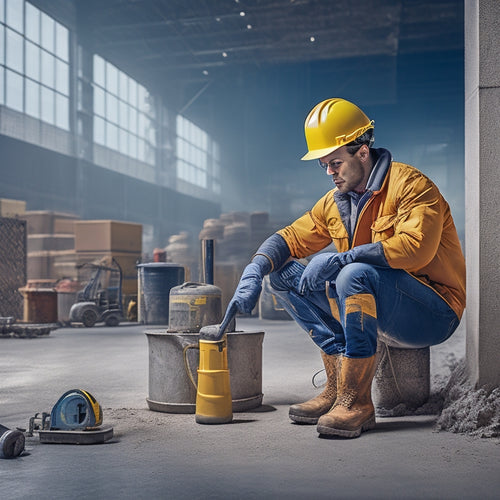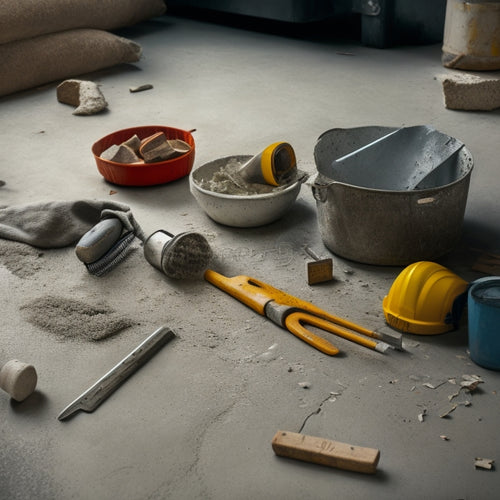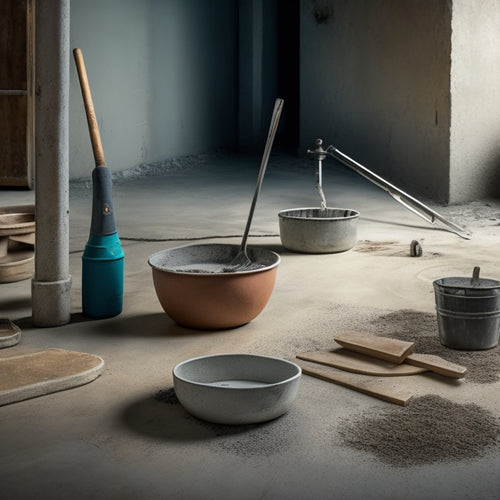
3 Best Tools for Concrete Block Patio Construction
Share
When building a concrete block patio, you'll need three essential tools to get started. First, a level guarantees your blocks are perfectly aligned and your patio is flat. Next, a trowel is necessary for applying and smoothing mortar between blocks. Finally, a jointer helps finish the joints for a polished look. With these fundamental tools in hand, you'll be well on your way to a successful patio construction project, and with further exploration, you'll discover the additional specialized equipment and accessories that will take your project to the next level.
Key Takeaways
• A level is essential for ensuring precise block alignment and overall flatness in concrete block patio construction.
• A trowel is necessary for applying and smoothing mortar between blocks for a strong bond.
• A jointer is required for finishing joints between blocks to achieve a polished look and professional finish.
• A block lifter/clamp helps secure and position blocks accurately, saving time and effort.
• Safety gear, including gloves, safety glasses, and a dust mask, is vital for protecting yourself from injury and harm.
Essential Masonry Tools Required
You'll need a set of essential masonry tools to verify a successful concrete block patio construction, starting with a level to assure precise block alignment and a spirit level to validate the patio's overall flatness.
These tools will help you achieve accurate measurements and guarantee a sturdy structure. Additionally, you'll require a trowel for applying and smoothing mortar, a jointer for finishing joints, and a hammer for tapping blocks into place.
Don't forget a pencil and straightedge for marking block positions and a string line for maintaining straight lines.
To maintain masonry safety, always wear protective gear, including gloves, safety glasses, and a dust mask.
Regularly inspect your tools for damage or wear, and perform routine tool maintenance to prevent accidents.
Clean and store your tools properly after each use, and replace worn or damaged parts promptly.
Concrete Block Laying Equipment
With the essential masonry tools in hand, it's time to focus on the specialized equipment necessary for efficiently laying concrete blocks, starting with a block lifter or clamp to securely grip and position blocks. This equipment enables you to handle blocks with precision, ensuring accurate placement and alignment.
You'll also need a level, both a spirit level and a laser level, to guarantee your blocks are perfectly horizontal and vertical. A string line and stakes will help you maintain straight lines and consistent spacing.
To achieve professional-looking joints, invest in a joint spacer or joint template. These tools will guide your block laying techniques, resulting in uniform joints and a polished finish.
Don't forget to prioritize equipment maintenance, regularly cleaning and lubricating your tools to prevent wear and tear.
Patio Construction Accessories Needed
Beyond the specialized equipment for laying concrete blocks, several patio construction accessories are necessary to guarantee a successful and professional-looking project.
You'll need a level, a tape measure, and a string line to ascertain accurate layouts and alignments. A mixing bucket, trowels, and jointing tools are essential for mixing and applying mortar, as well as finishing joints between blocks.
When it comes to patio design, you'll want to reflect on the surface finishes you'll be using. Will you be applying a sealant or stain to protect and enhance the appearance of your patio? If so, you'll need to have the necessary application tools, such as rollers or sprayers, on hand.
Additionally, you may want to incorporate decorative elements, like sand or gravel, into your patio design, which will require specialized tools for spreading and compacting.
Don't forget to have a sufficient supply of safety gear, including gloves, goggles, and a dust mask, to protect yourself from the physical demands of patio construction.
Frequently Asked Questions
What Safety Precautions Should I Take When Working With Heavy Concrete Blocks?
When handling heavy concrete blocks, you must prioritize safety above all.
You're lifting heavy loads, so master proper lifting techniques to avoid straining your back.
Always wear protective gear, including steel-toed boots, gloves, and safety glasses, to shield yourself from potential hazards.
Additionally, guarantee a stable and clear work area to prevent tripping and falling.
Can I Use a Circular Saw to Cut Concrete Blocks for a Patio?
When cutting concrete blocks for your patio, you'll need to choose the right tool for the job.
While a circular saw can be used, it's not the most ideal option. The saw blade will quickly become dull, and the dust created can be hazardous.
Instead, consider using a masonry saw or a diamond blade saw, which are specifically designed for cutting concrete. These tools will provide cleaner cuts and reduce dust.
Mastering the right cutting techniques will guarantee a professional-looking patio.
How Do I Ensure Drainage in My Concrete Block Patio Construction?
Did you know that 95% of patio failures are due to poor drainage?
To avoid this, you'll need to implement effective drainage solutions in your concrete block patio construction.
Start by ensuring a minimum patio slope of 1/8 inch per foot to allow water to flow away from your home.
Next, consider installing a French drain or a permeable paver system to direct water away from the patio.
What Is the Recommended Thickness for a Concrete Block Patio Slab?
When building a concrete block patio, you'll want to get the slab thickness just right.
Aim for a minimum of 4 inches for a pedestrian-only patio, but if you plan to add heavy furniture or accommodate vehicular traffic, you'll need to increase it to 5-6 inches.
A thicker slab guarantees patio durability, reducing the risk of cracking and shifting over time.
Proper slab thickness is essential, so don't skimp on this critical aspect of your patio's foundation.
Do I Need to Seal My Concrete Block Patio After Construction?
As you step onto your newly constructed concrete block patio, the fresh cement scent wafts up, and you envision the outdoor haven you're creating.
Now, you're wondering, 'Do I need to seal my concrete block patio after construction?' The answer is yes! Sealing offers benefits like protection from stains, enhanced durability, and easier maintenance.
You can opt for topical sealers, penetrating sealers, or even a combination of both methods.
Conclusion
As you put the finishing touches on your concrete block patio, the fruits of your labor come into focus.
With the right tools, the puzzle pieces fall into place, and your outdoor oasis begins to take shape.
The tamping tool smooths out the rough edges, the level guarantees a sturdy foundation, and the joint spade adds a touch of finesse.
Your concrete block patio is now a masterpiece, ready to withstand the elements and host countless memories.
Related Posts
-

10 Best Tools for Sealed Concrete Flooring on Budget
When starting on a sealed concrete flooring project on a budget, you'll need to prioritize essential tools without sa...
-

Top 10 Concrete Repair Tools for Small Fixes
You'll need the right tools to tackle small concrete repairs efficiently and effectively. When it comes to small fixe...
-

Why You Need These Concrete Overlay Tools
When tackling a concrete overlay project, you need the right tools to achieve a flawless finish and avoid costly mist...


